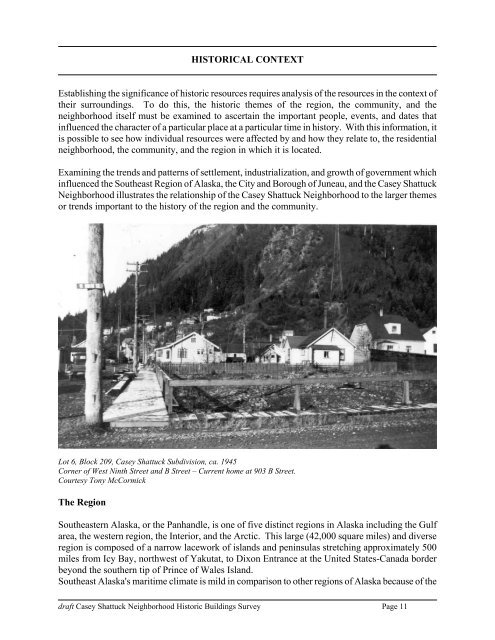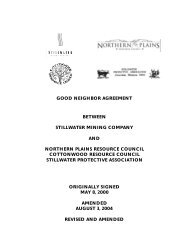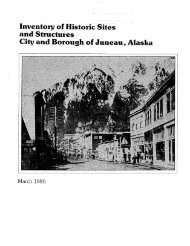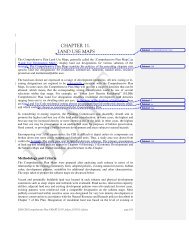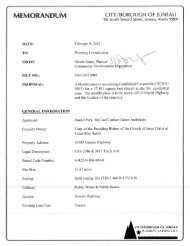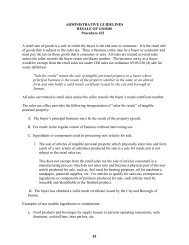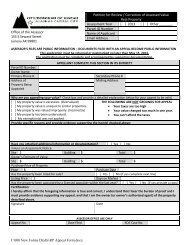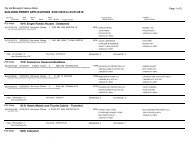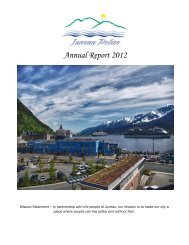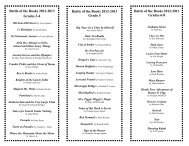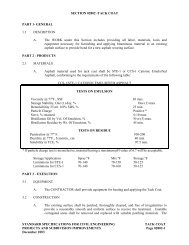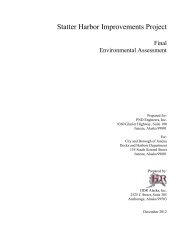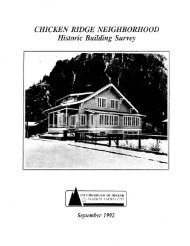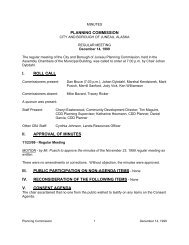Historical Context - The City and Borough of Juneau
Historical Context - The City and Borough of Juneau
Historical Context - The City and Borough of Juneau
Create successful ePaper yourself
Turn your PDF publications into a flip-book with our unique Google optimized e-Paper software.
HISTORICAL CONTEXT<br />
Establishing the significance <strong>of</strong> historic resources requires analysis <strong>of</strong> the resources in the context <strong>of</strong><br />
their surroundings. To do this, the historic themes <strong>of</strong> the region, the community, <strong>and</strong> the<br />
neighborhood itself must be examined to ascertain the important people, events, <strong>and</strong> dates that<br />
influenced the character <strong>of</strong> a particular place at a particular time in history. With this information, it<br />
is possible to see how individual resources were affected by <strong>and</strong> how they relate to, the residential<br />
neighborhood, the community, <strong>and</strong> the region in which it is located.<br />
Examining the trends <strong>and</strong> patterns <strong>of</strong> settlement, industrialization, <strong>and</strong> growth <strong>of</strong> government which<br />
influenced the Southeast Region <strong>of</strong> Alaska, the <strong>City</strong> <strong>and</strong> <strong>Borough</strong> <strong>of</strong> <strong>Juneau</strong>, <strong>and</strong> the Casey Shattuck<br />
Neighborhood illustrates the relationship <strong>of</strong> the Casey Shattuck Neighborhood to the larger themes<br />
or trends important to the history <strong>of</strong> the region <strong>and</strong> the community.<br />
Lot 6, Block 209, Casey Shattuck Subdivision, ca. 1945<br />
Corner <strong>of</strong> West Ninth Street <strong>and</strong> B Street – Current home at 903 B Street.<br />
Courtesy Tony McCormick<br />
<strong>The</strong> Region<br />
Southeastern Alaska, or the Panh<strong>and</strong>le, is one <strong>of</strong> five distinct regions in Alaska including the Gulf<br />
area, the western region, the Interior, <strong>and</strong> the Arctic. This large (42,000 square miles) <strong>and</strong> diverse<br />
region is composed <strong>of</strong> a narrow lacework <strong>of</strong> isl<strong>and</strong>s <strong>and</strong> peninsulas stretching approximately 500<br />
miles from Icy Bay, northwest <strong>of</strong> Yakutat, to Dixon Entrance at the United States-Canada border<br />
beyond the southern tip <strong>of</strong> Prince <strong>of</strong> Wales Isl<strong>and</strong>.<br />
Southeast Alaska's maritime climate is mild in comparison to other regions <strong>of</strong> Alaska because <strong>of</strong> the<br />
draft Casey Shattuck Neighborhood Historic Buildings Survey Page 11
warming influence <strong>of</strong> the Japanese Current. <strong>The</strong> first inhabitants <strong>of</strong> this hospitable region were the<br />
Tlingit, Tsimshian, <strong>and</strong> Haida Indians who established permanent villages <strong>and</strong> developed diverse<br />
<strong>and</strong> culturally rich societies. <strong>The</strong>se societies were greatly changed with coming <strong>of</strong> European<br />
explorers in the 18th century.<br />
In 1725, Peter the Great sent Vitus Bering <strong>and</strong> Alexei Chirik<strong>of</strong> to explore the North Pacific. On their<br />
second voyage in 1741, Chirik<strong>of</strong> spotted l<strong>and</strong> on July 15. In 1743, the Russians began concentrated<br />
hunting <strong>of</strong> sea otter pelts. Though the French, Spanish, <strong>and</strong> British explored the region, their<br />
presence was not as great as that <strong>of</strong> their Russian counterparts who, in 1784, established a settlement<br />
at Three Saints Bay on Kodiak Isl<strong>and</strong>. In 1808, Alex<strong>and</strong>er Baran<strong>of</strong>, governor <strong>of</strong> Russian America,<br />
moved his headquarters from Kodiak to Sitka in Southeast Alaska.<br />
In 1867 the United States purchased Alaska from Russia for the bargain price <strong>of</strong> $7.2 million dollars.<br />
Secretary <strong>of</strong> State William H. Seward, negotiator <strong>of</strong> the sale, was disparaged for his judgement<br />
because Alaska was considered a useless icebox. Because <strong>of</strong> this attitude, Alaska was ignored by<br />
the federal government for decades. Fortune hunters did not ignore the area however, because <strong>of</strong> the<br />
discovery <strong>of</strong> gold near Sitka in 1872. Rumors that gold existed in the northern section <strong>of</strong> Southeast<br />
around the Gastineau Channel area aroused further interest.<br />
<strong>The</strong> Gastineau Channel region was a fishing ground for local Tlingit Indians in 1880 when<br />
prospectors were searching for gold in Southeast Alaska. In Sitka, mining engineer George Pilz<br />
<strong>of</strong>fered a reward to any local Indian who could lead him to gold-bearing ore. When Cowee <strong>of</strong> the<br />
Auk Tlingit arrived with ore samples from Gastineau Channel, Pilz grubstaked prospectors Richard<br />
T. Harris <strong>and</strong> Joseph <strong>Juneau</strong> to investigate the lode.<br />
Gold Creek Flood, 1918, Core File # 01-29B<br />
Courtesy <strong>of</strong> the Alaska State <strong>Historical</strong> Library.<br />
draft Casey Shattuck Neighborhood Historic Buildings Survey Page 12
<strong>The</strong> Community<br />
Harris <strong>and</strong> <strong>Juneau</strong> reached Gastineau Channel in August 1880 <strong>and</strong> sampled the gravel <strong>of</strong> Gold<br />
Creek. <strong>The</strong>y found plenty <strong>of</strong> color, but did not follow the gold to its source. At Cowee's urging, Pilz<br />
sent the pair back again. This time Harris <strong>and</strong> <strong>Juneau</strong> climbed Snow Slide Gulch at the head <strong>of</strong> Gold<br />
Creek <strong>and</strong> located the mother lode <strong>of</strong> Quartz Gulch <strong>and</strong> Silver Bow Basin. <strong>The</strong>ir discovery led to<br />
the settling <strong>of</strong> <strong>Juneau</strong>, the first town founded in Alaska following the 1867 purchase from Russia. On<br />
October 18, they staked a 160-acre town site. <strong>The</strong>ir claim was entered into the record by Harris:<br />
"This is to certify that R.T. Harris, Joseph <strong>Juneau</strong>, <strong>and</strong> N.A. Fuller have this date<br />
recorded 160 acres for purposes <strong>of</strong> erecting a town site, commencing at a point<br />
one mile above the mouth <strong>of</strong> Gold Creek <strong>and</strong> running up the coast one-half mile<br />
<strong>and</strong> along the bay <strong>and</strong> anchorage right opposite Douglas Isl<strong>and</strong>, to be surveyed<br />
into 59 foot lots running back 200 feet, Said town site named <strong>and</strong> styled<br />
Harrisburg. October 18, 1880. R.T. Harris, Recorder."<br />
Harrisburg, Rockwell, or <strong>Juneau</strong> as it eventually came to be known, was situated on the shore <strong>of</strong><br />
Gastineau Channel under the shadows <strong>of</strong> Mount Roberts <strong>and</strong> Mount <strong>Juneau</strong>. A mining camp located<br />
on the beach, <strong>Juneau</strong> was composed <strong>of</strong> tents <strong>and</strong> cabins constructed <strong>of</strong> trees that grew throughout the<br />
town site, <strong>and</strong> supplies <strong>and</strong> materials brought from Sitka.<br />
Development in the fledgling town continued with the construction <strong>of</strong> the Log Cabin Church in<br />
1881, the Northwest Trading Company which was the first retail store in Harrisburgh, <strong>and</strong> the<br />
military post Rockwell. George Pilz shipped a pre-framed building from Sitka which became the<br />
first structure in town. In March 1881, Master Gustave Carl Hanus, a Navy <strong>of</strong>ficer from Sitka, ran<br />
lines to formally survey the new town which extended from the waterfront to a prominent ridge less<br />
than a mile away. <strong>The</strong> ridge area was later called Chicken Ridge. By the end <strong>of</strong> 1881, the town had<br />
a code <strong>of</strong> local laws, a Board <strong>of</strong> Public Safety to enforce them, <strong>and</strong> a post <strong>of</strong>fice.<br />
Construction proceeded at a steady pace <strong>and</strong> soon the town began to take shape. <strong>The</strong> downtown<br />
business district developed almost immediately. Court House Hill, later known as Telephone Hill,<br />
<strong>and</strong> nearby sections were quickly settled <strong>and</strong> as the population grew additional l<strong>and</strong> was staked <strong>and</strong><br />
cleared. Scattered houses were constructed on the wooded hillsides northeast <strong>of</strong> the business<br />
district. A Native village was established on the waterfront on the current site <strong>of</strong> Willoughby<br />
Avenue. Cabins for miners began to appear on Starr Hill, a working class residential area <strong>and</strong> by<br />
1893, the area <strong>of</strong> Chicken Ridge was being settled. In the nine years following the discovery <strong>of</strong> gold,<br />
<strong>Juneau</strong>'s population grew 800 percent from 150 to more than 1,200.<br />
Gold mining was the driving force behind this growth. At first the l<strong>and</strong> was placer mined; then<br />
prospectors attempted to work the larger, higher grade quartz veins they encountered by drilling <strong>and</strong><br />
blasting to break the gold-bearing quartz from the surrounding waste rock. Eventually, the<br />
prospectors began to consolidate adjoining properties <strong>and</strong> attack the deposit <strong>of</strong> quartz veins on a<br />
larger scale. By the 1890's, several <strong>of</strong> the small mining companies consolidated on a large scale <strong>and</strong><br />
out <strong>of</strong> this came the Treadwell, Alaska Gastineau, <strong>and</strong> the Alaska <strong>Juneau</strong> mining companies.<br />
As mining grew <strong>and</strong> large companies exp<strong>and</strong>ed the workings, it became apparent that <strong>Juneau</strong> would<br />
not be just another "boom <strong>and</strong> bust" gold camp. Rather, it enjoyed a growing prosperity built in the<br />
draft Casey Shattuck Neighborhood Historic Buildings Survey Page 13
mines, with their great mechanized mills, <strong>and</strong> large payroll. <strong>The</strong> three large mines, the Alaska<br />
Gastineau, the Alaska <strong>Juneau</strong>, <strong>and</strong> the Treadwell drove the economy. <strong>The</strong> latter two became the<br />
largest gold producers <strong>of</strong> low grade ore in the world, recovering more than $130 million from the<br />
mountain rock stamped to dust in the huge mills.<br />
<strong>The</strong> Treadwell closed in 1917 when three <strong>of</strong> its four operating mines collapsed in a saltwater cave-in<br />
<strong>and</strong> the Alaska Gastineau closed in 1921. <strong>The</strong> Alaska <strong>Juneau</strong> closed in 1944 due to the fixed price<br />
<strong>of</strong> gold, high operating costs, <strong>and</strong> a war-related labor shortage.<br />
For more than 60 years gold mining dominated the identity <strong>of</strong> <strong>Juneau</strong> <strong>and</strong> influenced its growth but<br />
the growth <strong>of</strong> government kept <strong>Juneau</strong>'s economy thriving after the decline <strong>of</strong> the gold mines. <strong>The</strong><br />
business <strong>of</strong> government had come about in 1900 when the town had been incorporated <strong>and</strong> <strong>Juneau</strong><br />
was designated the temporary seat <strong>of</strong> government <strong>of</strong> the territory. At this time, <strong>Juneau</strong> had the<br />
appearance <strong>of</strong> a thriving city <strong>and</strong> wooden buildings lined the streets. Residential areas had<br />
developed to house both miners <strong>and</strong> a growing number <strong>of</strong> white collar workers which comprised part<br />
<strong>of</strong> the nearly 2,000 people in the town.<br />
In 1900, the District Court moved from Sitka to <strong>Juneau</strong> <strong>and</strong> used rented quarters until 1904 when a<br />
new court house <strong>and</strong> jail were built at the site <strong>of</strong> the present State Office Building. <strong>The</strong> executive<br />
<strong>of</strong>fices moved from Sitka to <strong>Juneau</strong> in 1906. In 1912, Alaska was granted Territorial status <strong>and</strong> the<br />
first territorial legislature was convened. As the mining activities slowed, territorial <strong>and</strong> federal<br />
government <strong>of</strong>fices continued to grow in importance <strong>and</strong> replaced the mining companies as the chief<br />
industry <strong>of</strong> <strong>Juneau</strong>.<br />
<strong>The</strong> Southeast Region <strong>of</strong> Alaska was a region explored because <strong>of</strong> the possibility <strong>of</strong> great riches <strong>and</strong><br />
eventually settled because these possibilities proved to be true. <strong>The</strong> Russians came for fur <strong>and</strong><br />
established a strong grip on the area. After the United States purchased Alaska, prospectors<br />
searched for gold <strong>and</strong> found it in many places, including <strong>Juneau</strong>. It was this pattern <strong>of</strong> exploration<br />
<strong>and</strong> settlement which led to the founding <strong>of</strong> <strong>Juneau</strong>, Alaska. When the gold ran out, the city<br />
continued to thrive as a center for Territorial government. <strong>The</strong> success <strong>of</strong> the mining industry <strong>and</strong><br />
the transfer <strong>of</strong> Territorial<br />
government to <strong>Juneau</strong> fostered<br />
population growth. This<br />
population was composed not only<br />
<strong>of</strong> miners <strong>and</strong> government<br />
<strong>of</strong>ficials, but <strong>of</strong> entrepreneurs,<br />
doctors, lawyers, <strong>and</strong> others that<br />
invariably arrive at the beginning<br />
<strong>of</strong> a new town's birth. As a result,<br />
neighborhoods such as Starr Hill,<br />
Telephone Hill, Chicken Ridge,<br />
<strong>and</strong> Casey Shattuck were<br />
developed.<br />
Jimmy Larsen House<br />
428 West Twelfth Street, 1935<br />
Courtesy <strong>of</strong> the Larsen Family<br />
draft Casey Shattuck Neighborhood Historic Buildings Survey Page 14
<strong>The</strong> Neighborhood<br />
<strong>The</strong> development <strong>of</strong> the Casey Shattuck subdivision was a direct response to the housing needs <strong>of</strong> a<br />
growing community. <strong>The</strong> Treadwell <strong>and</strong> Alaska Gastineau gold mines were well under way <strong>and</strong><br />
growing. <strong>The</strong> Alaska <strong>Juneau</strong> gold mine was preparing to construct its giant mill <strong>and</strong> more than<br />
double its workforce. <strong>The</strong> AJ committed to the business community <strong>of</strong> <strong>Juneau</strong> not to develop its own<br />
company town. <strong>The</strong>y only provided housing for their single workers thus the market was strong for<br />
family housing. <strong>The</strong>re was also a significant fishing fleet in <strong>Juneau</strong> at that time <strong>and</strong> fishermen were<br />
looking for l<strong>and</strong> based locations to raise their families.<br />
Jimmy Larsen House<br />
704 West Eleventh Street, 1940<br />
Courtesy <strong>of</strong> the Larsen Family<br />
William Casey <strong>and</strong> brothers, Henry<br />
<strong>and</strong> Allen Shattuck, responded to<br />
the town’s need for developable<br />
l<strong>and</strong> with what was a subdivision<br />
targeted to the working class. <strong>The</strong><br />
lots were moderate in size, most<br />
being 40 feet by 90 feet. <strong>The</strong> l<strong>and</strong><br />
was level thus development costs<br />
were lower than in other areas <strong>of</strong><br />
town. And, the sales brokers<br />
<strong>of</strong>fered “easy terms” to make the<br />
properties affordable to the<br />
townspeople.<br />
A headline in the Alaska Daily Empire (August 8, 1913) stated, “Casey Shattuck Lots Go Like Hot<br />
Cakes.” <strong>The</strong> article claimed that 15 lots were sold on the first day <strong>of</strong> <strong>of</strong>fering <strong>and</strong> the sellers<br />
expected to have sold the entire subdivision within two weeks. <strong>The</strong> article went on to say that “most<br />
<strong>of</strong> the lots sold to residents, though several <strong>of</strong> the excursionists that were on the Spokane secured<br />
good lots in the tract.”<br />
Although the lots didn’t quite go as fast as the sellers anticipated, in less than four weeks nearly half<br />
had been sold <strong>and</strong> twelve new buildings were started. Some owners looking forward to constructing<br />
their homes found the lack <strong>of</strong> building materials available in town slowed their starting date. Clearly<br />
the Casey Shattuck subdivision started a building boom that perpetuated for some time. This boom<br />
<strong>of</strong>fered numerous opportunities for those in the construction industry. H.B. Foss, Company was a<br />
local architectural <strong>and</strong> engineering firm. <strong>The</strong>y designed many homes in the neighborhood.<br />
Contractors were kept busy <strong>and</strong> some made their debut <strong>and</strong> long-st<strong>and</strong>ing career in Casey Shattuck.<br />
One such builder was Jimmy Larsen.<br />
<strong>The</strong> following is an excerpt <strong>of</strong> an article first appearing in the Gastineau Heritage News, a<br />
publication <strong>of</strong> the Gastineau Channel <strong>Historical</strong> Society. <strong>The</strong> article entitled “<strong>Juneau</strong>’s First Suburb,<br />
<strong>The</strong> Casey Shattuck Addition” was written by Mark Kirch<strong>of</strong>f <strong>and</strong> Mike Blackwell. This section <strong>of</strong><br />
the article spotlights Jimmy Larsen, a builder <strong>of</strong> homes in the Casey Shattuck Neighborhood.<br />
“Aerial photos from the mid- to late 1920s show that about half <strong>of</strong> the available lots<br />
in the Casey Shattuck Addition were built on. That meant there was still another half<br />
draft Casey Shattuck Neighborhood Historic Buildings Survey Page 15
to go, <strong>and</strong> probably no other person influenced the development <strong>of</strong> the Flats more in<br />
the next several decades than a stout little carpenter named Jimmy Larsen.<br />
Jimmy Larsen<br />
Courtesy <strong>of</strong> the Larsen Family<br />
Larsen was born in Denmark in 1883. He emigrated to<br />
the United States in 1907, <strong>and</strong> eventually arrived in<br />
<strong>Juneau</strong> about 1913, where he made his home for the<br />
rest <strong>of</strong> his life. He worked a brief stint in the local<br />
mines, but that life wasn’t for him, so he became a<br />
building contractor, constructing more than 20 houses<br />
in the Casey Shattuck Addition where he himself<br />
lived.<br />
Jimmy’s first house on the Flats was at 603 Twelfth,<br />
which he built himself. Here he <strong>and</strong> his wife raised<br />
their son, Bob. Jimmy was a perfectionist, <strong>and</strong> the ads<br />
for his houses read “Jimmy Larsen built,” as a mark <strong>of</strong><br />
quality. He would get his ideas for house design from<br />
magazines or Sears Roebuck catalogs, <strong>and</strong> then<br />
embellish them. He had an innate ability to see <strong>and</strong><br />
imagine things in three dimensions.<br />
He also had an eye for beauty, <strong>and</strong> some <strong>of</strong> the trademarks <strong>of</strong> his houses are 45degree<br />
angle cuts on the window <strong>and</strong> door trim, decorative fireplaces, <strong>and</strong> built-in<br />
shelves. Almost all <strong>of</strong> his houses had basements <strong>and</strong> Ray furnaces. Other Larsen<br />
trademarks were tiled kitchen counters, hardwood floors, <strong>and</strong> seafoam green paint.<br />
Many Larsen houses were l<strong>and</strong>scaped before he sold them, <strong>and</strong> <strong>of</strong>tentimes he lived in<br />
a house for a short while to make sure everything worked perfectly.<br />
Men who worked for him recall that he was always into quality. If you dropped a<br />
nail, you went down the ladder to pick it up, <strong>and</strong> if you made a mistake, you started<br />
over. Jimmy personally h<strong>and</strong>picked all the lumber that went into his houses from<br />
Columbia Lumber Company. He was a distinctive character in town driving around<br />
in his Dodge truck, clad in Oshkosh overalls <strong>and</strong> wooden shoes. <strong>The</strong> son <strong>of</strong> a farmer,<br />
at his own house there were tiger lilies, potatoes, <strong>and</strong> hives <strong>of</strong> bees.<br />
Perhaps the most notable Jimmy Larsen houses in the Casey Shattuck Addition are<br />
the four clumped together at 506, 519, 521, <strong>and</strong> 525 Ninth Street. <strong>The</strong>y were finished<br />
late in his career <strong>and</strong> are prime examples <strong>of</strong> his craftsmanship. <strong>The</strong> house at 525<br />
Ninth was one he built for himself in 1952, <strong>and</strong> where he died in 1957.<br />
Jimmy was also an important figure in the lives <strong>of</strong> neighborhood children. For many<br />
years there was an underst<strong>and</strong>ing between Larsen <strong>and</strong> the younger crowd in Casey<br />
Shattuck that the houses that he was constructing were available for play after<br />
working hours, so long as there was no v<strong>and</strong>alism or theft. So, from basement<br />
excavation to close-in, Larsen houses provided fortresses, complete with scaffolding,<br />
ladders, <strong>and</strong> weapons for repelling invaders.<br />
<strong>The</strong> fortresses provided by Jimmy (there was always at least one under construction),<br />
draft Casey Shattuck Neighborhood Historic Buildings Survey Page 16
the “Woods,” the limitless open space <strong>of</strong> the cemetery <strong>and</strong> ball park, <strong>and</strong> the hairraising<br />
winter sledding on Ninth Street Hill provided, arguably, the best terrain for<br />
adventure in the whole city.<br />
<strong>Juneau</strong> was a good place for Jimmy Larsen <strong>and</strong> other building contractors to work in<br />
the 1930s, because unlike most other places, <strong>Juneau</strong> was little affected by the Great<br />
Depression. <strong>The</strong> mines continued to employ close to a thous<strong>and</strong> workers <strong>and</strong> they all<br />
needed places to live. <strong>Juneau</strong> was growing, <strong>and</strong> Casey Shattuck was no longer on the<br />
edge <strong>of</strong> town.”<br />
<strong>The</strong> Casey Shattuck Neighborhood clearly was an important development in the history <strong>of</strong><br />
<strong>Juneau</strong>. It provided home ownership opportunities to the working class <strong>of</strong> the community <strong>and</strong> a<br />
favorable neighborhood in which to raise families. A number <strong>of</strong> current residents have lived in<br />
the neighborhood for 60 to 70 years. <strong>The</strong> neighborhood remains a desirable place to call home,<br />
as it is quiet, comfortable <strong>and</strong> convenient.<br />
Jimmy Larsen House<br />
518 West Twelfth Street, 1935<br />
Courtesy <strong>of</strong> the Larsen Family<br />
Jimmy Larsen House<br />
436 West Twelfth Street, 1935<br />
Courtesy <strong>of</strong> the Larsen Family 436 West Tr<br />
draft Casey Shattuck Neighborhood Historic Buildings Survey Page 17


